Cynnwys
- Main points
- Tell us what you think
- Pre-release access to ONS statistics
- What’s changed in this release?
- Things you need to know about this release
- How much is the public sector borrowing?
- How big is public sector debt?
- How much cash does the public sector need to raise?
- How was debt in the current financial year-to-date accumulated?
- How do these figures compare with official forecasts?
- Revisions since previous release
- International comparisons of borrowing and debt
- Quality and methodology
1. Main points
Public sector net borrowing (excluding public sector banks) increased by £1.9 billion to £22.8 billion in the current financial year-to-date (April 2017 to June 2017), compared with the same period in 2016.
The Office for Budget Responsibility (OBR) forecast that public sector net borrowing (excluding public sector banks) will be £58.3 billion during the financial year ending March 2018.
Public sector net borrowing (excluding public sector banks) increased by £2.0 billion to £6.9 billion in June 2017, compared with June 2016.
Public sector net borrowing (excluding public sector banks) decreased by £25.9 billion to £46.2 billion in the financial year ending March 2017 (April 2016 to March 2017) compared with the financial year ending March 2016; this is the lowest net borrowing since the financial year ending March 2008.
The Office for Budget Responsibility (OBR) forecast that public sector net borrowing (excluding public sector banks) would be £51.7 billion during the financial year ending March 2017.
Public sector net debt (excluding public sector banks) was £1,753.5 billion at the end of June 2017, equivalent to 87.4% of gross domestic product (GDP), an increase of £128.5 billion (or 3.6 percentage points as a ratio of GDP) on June 2016.
Public sector net debt (excluding both public sector banks and Bank of England) was £1,623.5 billion at the end of June 2017, equivalent to 80.9% of GDP; an increase of £41.9 billion (or a decrease of 0.6 percentage points as a ratio of GDP) on June 2016.
Central government net cash requirement decreased by £15.5 billion; from £27.0 billion, to £11.5 billion in the current financial year-to-date (April 2017 to June 2017), compared with the same period in 2016; this is the lowest year-to-date central government net cash requirement since 2002.
2. Tell us what you think
About sub-regional public sector finances
The Sub-national Public Sectors Finances (PSF) consultation aims to gather user views on public sector finance statistics at local area geographies, whether that be country, region, local authority or other sub-UK geography.
It is related to two recent Office for National Statistics (ONS) publications: the Country and regional public sector finances bulletin and the Sub-regional public sector finances scoping study. The consultation opened on 3 July 2017 and closes on 11 September 2017.
We are looking forward to hearing your views and working together further to improve our sub-national public sector finance statistics.
About this bulletin
As part of our continuous engagement strategy, we welcome your feedback on ways in which this bulletin can be improved. Please email us at public.sector.accounts@ons.gov.uk with your views.
Nôl i'r tabl cynnwys3. Pre-release access to ONS statistics
On 15 June 2017, the National Statistician announced that from 1 July 2017 pre-release access to Office for National Statistics (ONS) statistics would cease. This is the first public sector finance bulletin to be released with no pre-release access.
The public sector finances bulletin is jointly produced by members of the Government Statistical Service (GSS) working in both ONS and HM Treasury. GSS staff will continue to work together to produce the bulletin but ministers and those officials not directly involved in the production and release of statistics will not have access to them in advance of publication.
Nôl i'r tabl cynnwys4. What’s changed in this release?
This section presents information on aspects of data or methodology that is important to understand when reading this bulletin. Where appropriate, further details of individual changes are discussed in the “Quality and methodology” section of this bulletin.
Apprenticeship Levy
In April 2017, the government introduced an Apprenticeship Levy, payable by any employer with a pay bill over £3 million each year.
In June 2017, this levy was classified by ONS as a tax on production, with £360 million pounds collected so far this financial year (April to June 2017) under the scheme. Pending the classification decision, we recorded the £162 million collected prior to June 2017 as a tax on income and wealth. This payment has now been correctly recorded based on the classification decision, with no effect on net borrowing.
How early estimates of the components of net borrowing are improved over time
Since the first estimate of public sector net borrowing (excluding public sector banks) for the financial year ending March 2017 (April 2016 to March 2017), was published on 25 April 2017, the estimate has been revised downwards by £5.8 billion, from £52.0 billion to £46.2 billion; these are still not final figures and will be revised over the coming months as we replace our initial estimates with provisional and then final out-turn data.
The data for the latest month of every release contains some forecast data. The initial out-turn estimates for the early months of the financial year, particularly April, contain more forecast data than other months, as profiles of tax receipts, along with departmental and local government spending are still provisional. This means that the data for these months are typically more prone to revision than other months and can be subject to sizeable revisions in later months.
Appendix G: Revisions to the first reported estimate of financial-year-end public sector net borrowing (excluding public sector banks) by sub-sector; summarises revisions to the first estimate of public sector net borrowing (excluding public sector banks) by sub-sector for the last 6 financial years. Revisions are shown at 6 and 12 months after year end.
We have published an article, Public Sector Finances – Sources summary and their timing, which provides a brief summary of the different sources used and the implications of using those data in the monthly public sector finances (PSF) statistical bulletin.
Nôl i'r tabl cynnwys5. Things you need to know about this release
What are the most important terms I need to know?
Public sector net borrowing excluding public sector banks (PSNB ex) measures the gap between revenue raised (current receipts) and total spending (current expenditure plus net investment (capital spending less capital receipts)). Public sector net borrowing is often referred to as “the deficit”.
The public sector net cash requirement (PSNCR) represents the cash needed to be raised from the financial markets over a period of time to finance the government’s activities. This can be close to the deficit for the same period but there are some transactions, for example, loans to the private sector, which need to be financed but do not contribute to the deficit. It is also close but not identical to the changes in the level of net debt between two points in time.
Public sector net debt excluding public sector banks (PSND ex) represents the amount of money the public sector owes to private sector organisations including overseas institutions, largely as a result of issuing gilts and treasury bills, less the amount of cash and other short-term assets it holds.
While borrowing (or the deficit) represents the difference between total spending and receipts over a period of time, debt represents the total amount of money owed at a point in time.
The debt has been built up by successive government administrations over many years. When the government borrows (that is, runs a deficit), this normally adds to the debt total. So reducing the deficit is not the same as reducing the debt.
If you’d like to know more about the relationship between debt and deficit, please refer to our article The debt and deficit of the UK public sector explained.
What does the public sector include?
In the UK, the public sector consists of five sub-sectors: central government, local government, public non-financial corporations, Bank of England and public financial corporations (or public sector banks).
Unless otherwise stated, the figures quoted in this bulletin exclude public sector banks (that is currently only Royal Bank of Scotland (RBS)), as the reported position of debt (and to a lesser extent borrowing) would be distorted by the inclusion of RBS's balance sheet (and transactions). This is because government does not need to borrow to fund the debt of RBS, nor would surpluses achieved by RBS be passed on to government, other than through any dividends paid as a result of government equity holdings
The sub-sector breakdown of public sector net borrowing is summarised in Table PSA2 in the Public sector finances tables 1 to 10: Appendix A dataset.
Should I look at monthly or financial year-to-date data to understand public sector finances?
A financial year is an accounting period of 12 months running from 1 April one year to 31 March the following year. For example, the financial year ending March 2016 comprises the months from April 2015 to March 2016.
Due to the volatility of the monthly data, the cumulative financial year-to-date borrowing figures provide a better indication of the position of the public finances than the individual months.
Are our figures adjusted for inflation?
All monetary values in the public sector finances (PSF) bulletin are expressed in terms of “current prices‟, that is, they represent the price in the period to which the expenditure or revenue relates and are not adjusted for inflation.
In order to compare data over long time periods, to aid international comparisons and provide an indication of a country’s ability to service borrowing and debt, commentators often discuss changes over time to fiscal aggregates in terms of gross domestic product (GDP) ratios. GDP represents the value of all the goods and services currently produced by the UK economy in a period of time.
Are our figures adjusted for seasonal patterns?
All monetary values in the PSF bulletin are not seasonally adjusted. We recommend you use year-on-year comparisons (be it cumulative financial year-to-date or individual monthly borrowing figures) rather than making month-on-month comparisons.
Are our monthly figures likely to change over time?
Each PSF bulletin contains the first estimate of public sector borrowing for the most recent period and is likely to be revised in later months as more data become available.
In publishing monthly estimates, it is necessary to use a range of different types of data sources. Some of these are subject to revision as budget estimates (forecasts) are replaced by out-turn data and these then feed into the published aggregates. In addition to those that stem from updated data sources, revisions can also result from methodology changes. An example of the latter is the changes that were due to the introduction of improved methodology for the recording of Corporation Tax, Bank Corporation Tax Surcharge receipts and Bank Levy implemented in the PSF estimates released in February 2017.
How is the debt interest paid by the government affected by movements in the level of RPI?
Index-linked gilts, a form of government bond, are indexed to the Retail Prices Index (RPI). When the RPI rises, the inflation uplift that applies to index-linked cash flows (both regular coupon payments and final payment at gilt maturity) also rises. If the RPI should fall, the inflation uplift would also fall. In this way, the returns to the investor from holding index-linked gilts are maintained in real terms - as measured by the RPI.
Taking £100 as the unit price for a gilt, an index-linked gilt will pay more than £100 at redemption if the RPI increases over the life of the gilt. Similarly, if the RPI increases over the life of the gilt each coupon payment will be higher than the previous one; while if the RPI were to decrease, a coupon payment could be lower than the previous one.
Both the uplift on coupon payments and the uplift on the redemption value are recorded as debt interest paid by the government, so month-on-month there can be sizeable movements in payable government debt interest as a result of movements in the RPI.
Nôl i'r tabl cynnwys6. How much is the public sector borrowing?
In the current financial year-to date, (April 2017 to June 2017), the public sector spent more money than it received in taxes and other income. This meant it had to borrow £22.8 billion; £1.9 billion more than in the same period in the previous financial year.
Of this £22.8 billion of public sector net borrowing excluding public sector banks (PSNB ex), £17.1 billion related to the cost of the “day-to-day” activities of the public sector (the current budget deficit), while £5.7 billion related to capital spending (or net investment) such as infrastructure.
Figure 1 presents cumulative public sector net borrowing (excluding public sector banks) by month in the current financial year-to-date and compares the cumulative borrowing with that in the previous financial year.
Figure 1: Public sector net borrowing (excluding public sector banks)
UK
Source: Office for National Statistics
Download this chart Figure 1: Public sector net borrowing (excluding public sector banks)
Image .csv .xlsThe difference between central government's income and spending makes the largest contribution to the amount borrowed by the public sector. In the current financial year-to-date, of the £22.8 billion borrowed by the public sector, £26.4 billion was borrowed by central government, while local government net borrowing was in surplus by £5.2 billion.
In the current financial year-to-date, central government received £164.2 billion in income; including £119.6 billion in taxes. This was around 5% more than in the same period in the previous financial year.
Over the same period, central government spent £185.7 billion; around 5% more than in the same period in the previous financial year. Of this amount, just below two-thirds was spent by central government departments (such as health, education and defence), around one-third on social benefits (such as pensions, unemployment payments, Child Benefit and Maternity Pay) with the remaining being spent on capital investment and interest on government’s outstanding debt.
Figure 2 summarises public sector borrowing by sub-sector in the current financial year-to-date (April to June 2017) and compares these with the same period in the previous financial year.
This presentation splits PSNB ex into each of its four sub-sectors: central government, local government, public corporations and Bank of England.
A further breakdown (receipts, expenditure (both current and capital) and depreciation) is provided for central government, local government and public corporations; with central government current receipts and current expenditure being presented in further detail.
Figure 2: Contributions to public sector net borrowing (excluding public sector banks) by sub-sector in the current financial year-to-date (April to June 2017)
UK
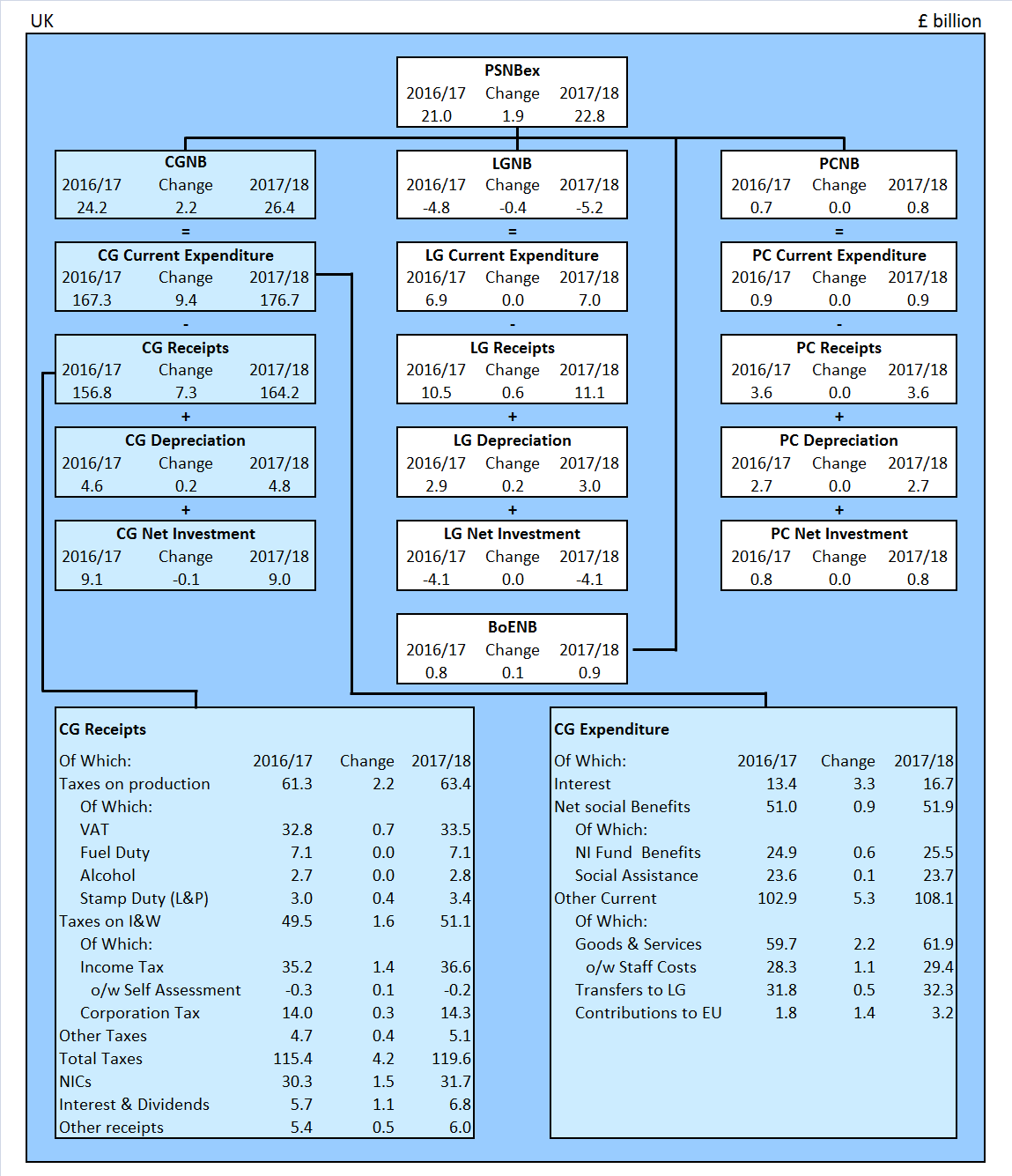
Source: Office for National Statistics
Notes:
- PSNBex - Public sector net borrowing excluding public sector banks.
- CGNB - Central government net borrowing.
- LGNB - Local government net borrowing.
- PCNB - Non-financial public corporations' net borrowing.
- BoENB - Bank of England net borrowing.
- L&P - Land and property.
- I&W - Income and wealth.
- NICs - National Insurance contributions.
- Contributions to EU - UK VAT, GNI and abatement contributions to the EU budget.
Download this image Figure 2: Contributions to public sector net borrowing (excluding public sector banks) by sub-sector in the current financial year-to-date (April to June 2017)
.png (102.8 kB) .xls (67.1 kB)Figure 3 illustrates that annual borrowing has generally been falling since the peak in the financial year ending March 2010 (April 2009 to March 2010).
Early estimates indicate that in the full financial year ending March 2017 (April 2016 to March 2017), the public sector borrowed £46.2 billion, or 2.4% of gross domestic product (GDP). This was £25.9 billion lower than in the previous full financial year and around one-third of that in the financial year ending March 2010, when borrowing was £151.7 billion or 9.9% of GDP.
Figure 3: Public sector net borrowing (excluding public sector banks), April 1993 to June 2017
UK
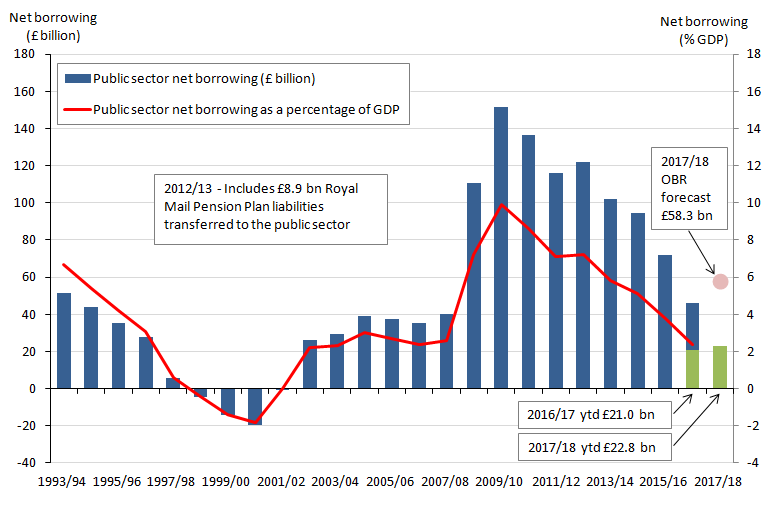
Source: Office for National Statistics
Notes:
- Financial year 2017/18 represents the financial year ending 2018 (April 2017 to March 2018).
- Office for Budget Responsibility (OBR) full financial year forecast of £58.3 billion for public sector net borrowing excluding public sector banks (March 2017 Economic and Fiscal Outlook).
- ytd equals year-to-date (April to June).
Download this image Figure 3: Public sector net borrowing (excluding public sector banks), April 1993 to June 2017
.png (36.5 kB) .xls (67.6 kB)Focusing on the current month
In June 2017, the public sector spent more money than it received in taxes and other income. This meant it had to borrow £6.9 billion; £2.0 billion more than in June 2016.
Figure 4 summarises public sector borrowing by sub-sector in June 2017 and compares this with the equivalent measures in the same month a year earlier (June 2016).
This presentation splits public sector net borrowing excluding public sector banks (PSNB ex) into each of its four sub-sectors: central government, local government, public corporations and Bank of England.
A further breakdown (receipts, current expenditure, capital expenditure and depreciation) is provided for central government, local government and public corporations; with central government current receipts and current expenditure being presented in further detail.
Both local government and public corporations data for June 2017 are initial estimates. Most of these components are calculated by Office for National Statistics (ONS) based on Office for Budget Responsibility (OBR) forecasts. Administrative source data are used for transfers to each of these sectors from central government.
Contribution to the EU budget
Every year the European Commission (EC) reports retrospective adjustments to the EU budget contributions of EU member states based on the latest Value Added Tax (VAT) and gross national income (GNI) data.
In June 2017, the UK paid £1,249 million to the EU budget through GNI and VAT based contributions, which are made net of the UK rebate. This payment consisted of our standard monthly VAT and GNI based contribution of £991 million, along with a £258 million payment adjustment covering earlier years, which will be subject to a further UK rebate (as set out in the OBR’s March 2017 Forecast).
Figure 4: Contributions to public sector net borrowing (excluding public sector banks) by sub-sector in June 2017, compared with June 2016
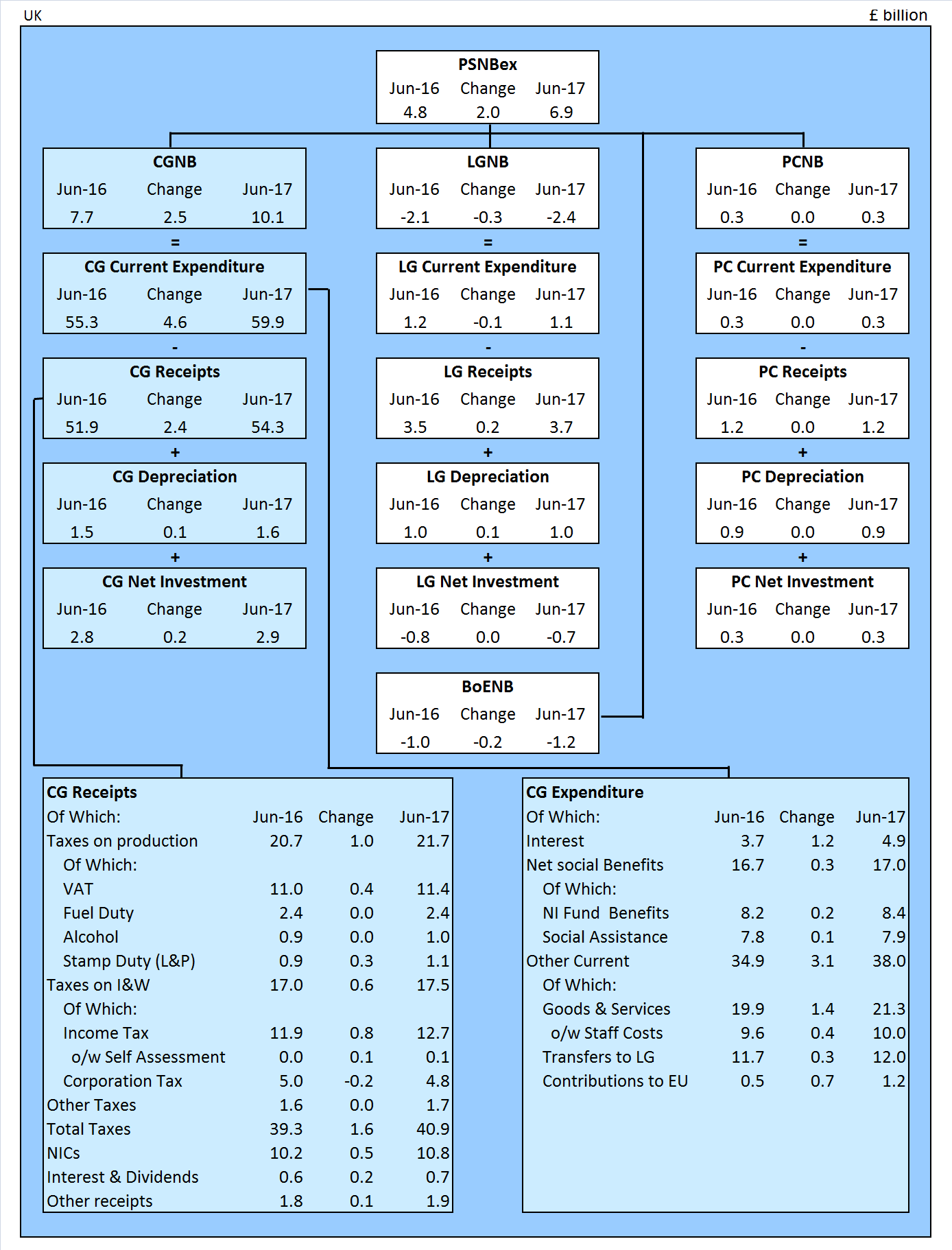
Source: Office for National Statistics
Notes:
- PSNBex - Public sector net borrowing excluding public sector banks.
- CGNB - Central government net borrowing.
- LGNB - Local government net borrowing.
- PCNB - Non-financial public corporations' net borrowing.
- BoENB - Bank of England net borrowing.
- L&P - Land and property.
- I&W - Income and wealth.
- NICs - National Insurance contributions.
- Contributions to EU - UK VAT, GNI and abatement contributions to the EU budget.
Download this image Figure 4: Contributions to public sector net borrowing (excluding public sector banks) by sub-sector in June 2017, compared with June 2016
.png (139.0 kB) .xls (67.1 kB)7. How big is public sector debt?
The amount of money owed by the public sector to the private sector stood at nearly £1.8 trillion at the end of June 2017, which equates to 87.4% of the value of all the goods and services currently produced by the UK economy in a year (or gross domestic product (GDP)).
This £1.8 trillion (or £1,753.5 billion) debt at the end of June 2017 represents an increase of £128.5 billion since the end of June 2016. Of this £128.5 billion, £86.6 billion is attributable to debt accumulated within the Bank of England, nearly all of it in the Asset Purchase Facility. Of this £86.6 billion, £69.3 billion relates to the Term Funding Scheme (TFS).
Figure 5 breaks down outstanding public sector net debt at the end of June 2017 into the sub-sectors of the public sector. In addition to public sector net debt excluding public sector banks (PSND ex), this presentation includes the impact of public sector banks on debt.
Figure 5: Contributions to public sector net debt by sub-sector at the end of June 2017
UK
Source: Office for National Statistics
Notes:
- PSND - Public sector net debt.
- PSBsND - Public sector Banks net debt.
- PSND ex - Public sector net debt excluding public sector banks.
- BoEND - Bank of England's contribution to net debt.
- PSND ex Boe - Public sector net debt excluding both public sector banks and Bank of England.
- NFPCND - Non-financial public corporations' net debt.
- GGND - General government net debt.
Download this chart Figure 5: Contributions to public sector net debt by sub-sector at the end of June 2017
Image .csv .xlsNet debt is defined as total gross financial liabilities less liquid financial assets, where liquid assets are cash and short-term assets, which can be released for cash at short notice without significant loss. These liquid assets mainly comprise foreign exchange reserves and bank deposits.
Figure 6 presents public sector net debt excluding public sector banks (PSND ex) at the end of June 2017 by sub-sector. Time series for each of these component series are presented in Tables PSA8A to D in the Public sector finances tables 1 to 10: Appendix A dataset.
Figure 6: Contributions to public sector net debt (excluding public sector banks) by sub-sector at the end of June 2017 (£ billion)
UK
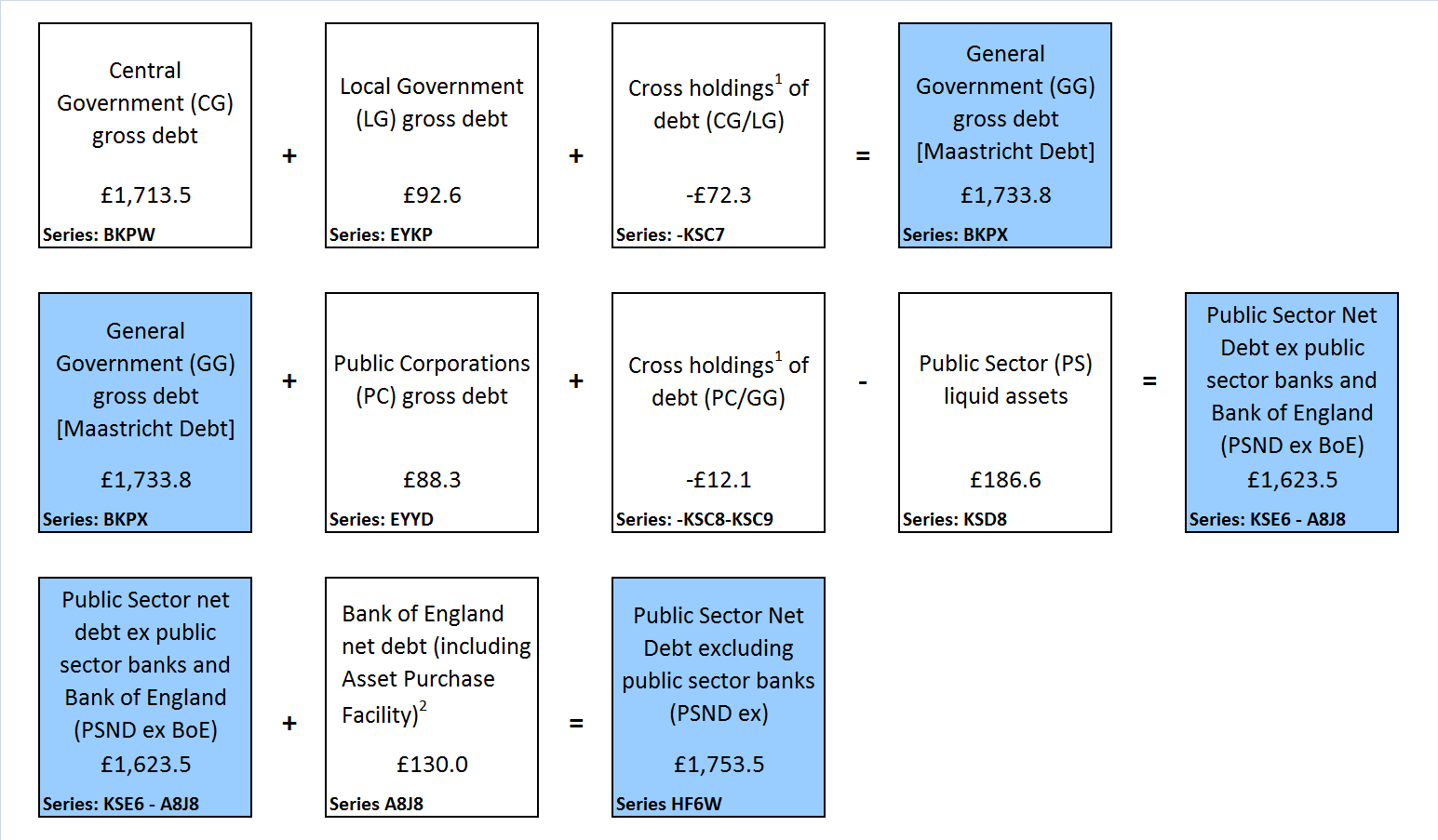
Source: Office for National Statistics
Notes:
- Cross-holdings between sub-sectors are removed in calculating public sector net debt, gross debt and liquid assets.
- APF - Bank of England Asset Purchase Facility.
Download this image Figure 6: Contributions to public sector net debt (excluding public sector banks) by sub-sector at the end of June 2017 (£ billion)
.png (73.3 kB) .xls (166.4 kB)Figure 7 illustrates PSND ex from the financial year ending March 1994 to the end of June 2017.
Figure 7: Public sector net debt (excluding public sector banks), March 1994 to the end of June 2017
UK
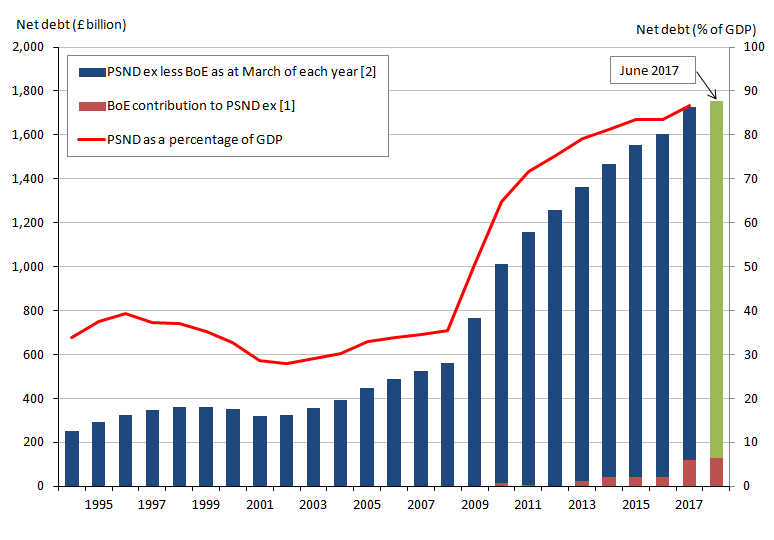
Source: Office for National Statistics
Notes:
- Includes Asset Purchase Facility (APF), which includes the Term Funding Scheme (TFS).
- Public sector net debt excluding public sector banks (PSND ex) is the combination of PSND ex less Bank of England (BoE) plus BoE contribution to PSND ex.
Download this image Figure 7: Public sector net debt (excluding public sector banks), March 1994 to the end of June 2017
.png (37.0 kB) .xls (48.1 kB)PSND ex increased at the time of the economic downturn. Since then, it has continued to increase but at a slower rate. The introduction of the Term Funding Scheme in late 2016 has led to a rise in net debt, as the loans provided under the scheme are not liquid assets and therefore do not net off in public sector net debt (against the liabilities incurred in providing the loans).
Nôl i'r tabl cynnwys8. How much cash does the public sector need to raise?
The net cash requirement is a measure of how much cash the public sector needs to raise from the financial markets (or pay out from its cash reserves) to finance its activities. This amount can be close to the deficit for the same period but there are some transactions, for example, lending to the private sector or the purchase of shares, that need to be financed but do not contribute to the deficit. Similarly, repayments of principal on loans extended by government or sales of shares will reduce the level of financing necessary but not reduce the deficit.
Figure 8 presents public sector net cash requirement by sub-sector in the current financial-year-to-date (April 2017 to June 2017). Time series for each of these component series are presented in Table PSA7A in the Public sector finances tables 1 to 10: Appendix A dataset.
Figure 8 - Contributions to public sector net cash requirement (excluding public sector banks) by sub-sector in the current financial year-to-date (April to June 2017) (£ billion)
UK
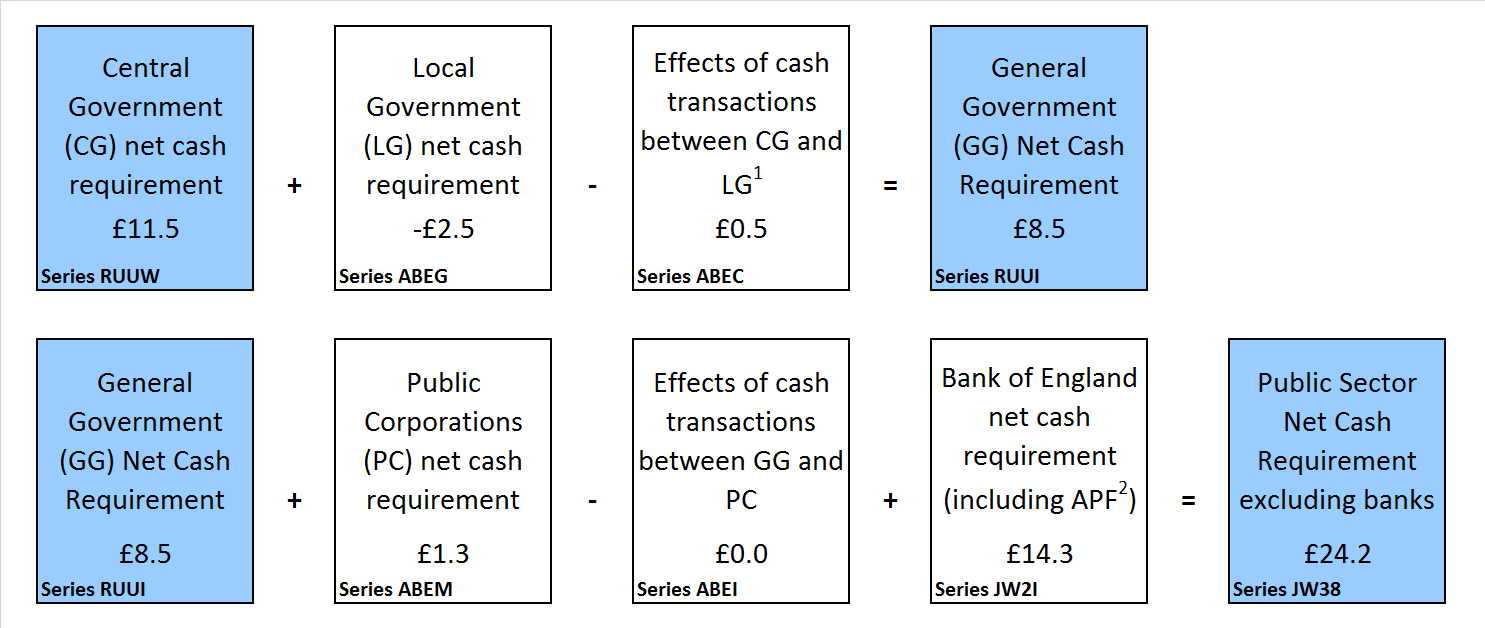
Source: Office for National Statistics
Notes:
- Effects of cash transactions between sub-sectors are removed in calculating public sector total net cash requirement (and consolidated expenditure and income totals).
- APF - Bank of England Asset Purchase Facility.
Download this image Figure 8 - Contributions to public sector net cash requirement (excluding public sector banks) by sub-sector in the current financial year-to-date (April to June 2017) (£ billion)
.png (53.0 kB) .xls (152.6 kB)Central government net cash requirement (CGNCR) is a focus for some users, as it provides an indication of the volume of gilts (government bonds) the Debt Management Office may issue to meet the government’s borrowing requirements.
CGNCR is quoted both including and excluding the net cash requirement of Network Rail (NR) and UK Asset Resolution LTD (UKAR) (which manages the closed mortgage books of both Bradford and Bingley, and Northern Rock Asset Management). It is the CGNCR excluding NR and UKAR that is the particular focus of users with an interest in the gilt market.
CGNCR excluding NR and UKAR decreased by £16.8 billion to £12.4 billion in the current financial year-to-date (April 2017 to June 2017), compared with the same period in 2016.
Nôl i'r tabl cynnwys9. How was debt in the current financial year-to-date accumulated?
Figure 9 brings together the borrowing components detailed in Figure 2 to illustrate how the differences between income and spending (both current and capital) have led to the accumulation of debt in the current financial year-to-date (April to June 2017).
This presentation excludes public sector banks, focusing instead on the public sector net borrowing excluding public sector banks (PSNB ex) measure.
Figure 9: How the difference in expenditure and receipts impact on public sector net debt (excluding public sector banks)
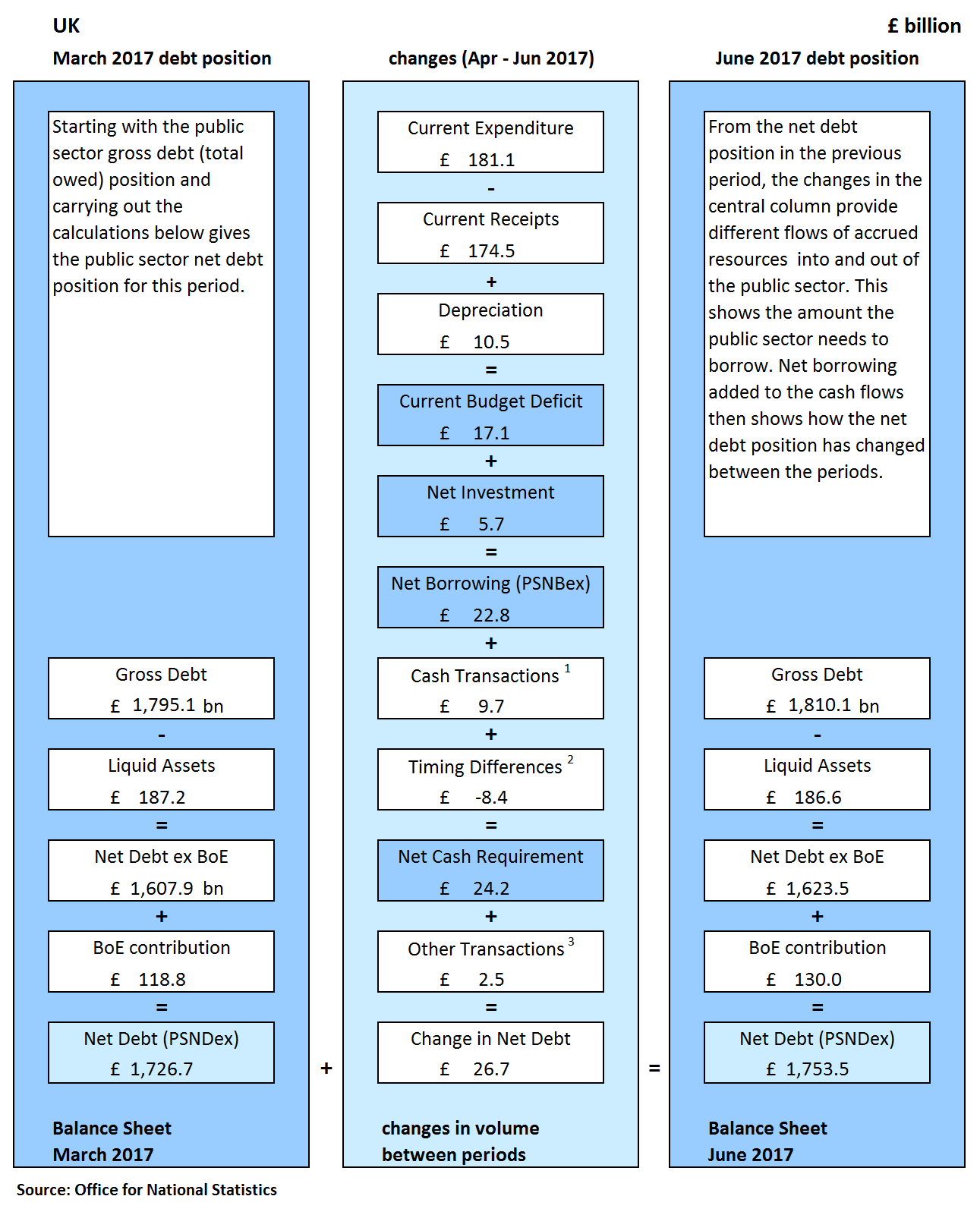
Source: Office for National Statistics
Notes:
- Cash transactions in (non-financing) financial assets, which do not impact on net borrowing.
- Timing differences between cash and accrued data.
- Revaluation of foreign currency debt (for example, foreign currency). Debt issuances or redemptions above or below debt valuation (for example, bond premia and discounts and capital uplifts). Changes in volume of debt not due to transactions (for example, sector reclassification).
Download this image Figure 9: How the difference in expenditure and receipts impact on public sector net debt (excluding public sector banks)
.png (134.6 kB) .xls (42.5 kB)The reconciliation between public sector net borrowing and net cash requirement is presented in more detail in Table REC1 in the Public sector finances tables 1 to 10: Appendix A dataset.
Nôl i'r tabl cynnwys10. How do these figures compare with official forecasts?
The Office for Budget Responsibility (OBR) normally produces forecasts of the public finances twice a year (currently in March and November). The latest OBR forecast was published on 8 March 2017.
The government has adopted OBR forecasts as its official forecast.
OBR forecast that the public sector would borrow £51.7 billion during the financial year ending March 2017, a reduction of £20.4 billion on out-turn for the financial year ending March 2016. The provisional out-turn estimate for the financial year ending March 2017 was £46.2 billion; £5.5 billion less than the OBR forecast.
OBR forecast that the public sector will borrow £58.3 billion during the current financial year (April 2017 to March 2018); an increase of £12.1 billion on the current out-turn estimate for the financial year ending March 2017. In the current financial year-to-date (April to June 2017), the public sector has borrowed £22.8 billion; an increase of £1.9 billion on the same period in the last financial year.
Figure 10 presents the cumulative public sector net borrowing for the latest and previous full financial years. The figure also presents the OBR forecasts for the corresponding financial years.
Figure 10: Cumulative public sector net borrowing (excluding public sector banks)
UK
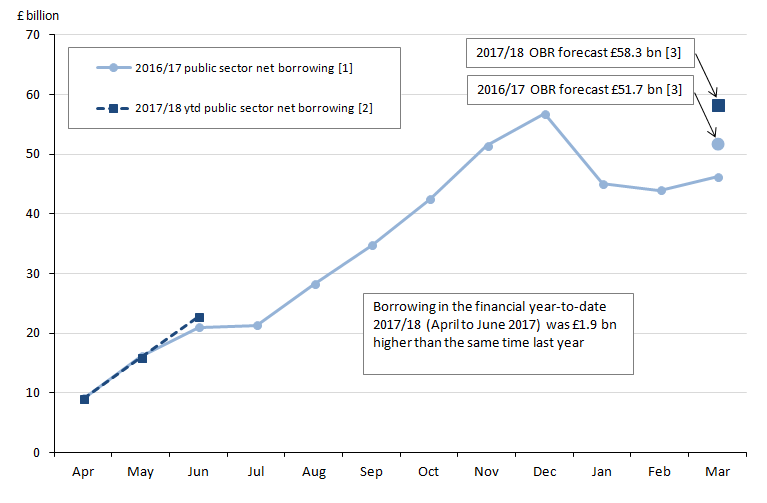
Source: Office for National Statistics
Notes:
- For the financial year ending 2017 (April 2016 to March 2017) and the financial year ending 2018 (April 2017 to March 2018).
- OBR forecast for public sector net borrowing excluding public sector banks from March 2017 Economic and Fiscal Outlook (EFO).
Download this image Figure 10: Cumulative public sector net borrowing (excluding public sector banks)
.png (20.9 kB) .xls (171.5 kB)Table 1 compares the first estimates of full financial year data against the OBR forecasts. Caution should be taken when comparing public sector finances data with OBR figures for the full financial year, as data are not finalised until after the financial year ends.
Initial estimates soon after the end of the financial year can be subject to sizeable revisions in later months.
In addition, the monthly path of spending and receipts is not smooth within the year and also can vary compared with previous years, both of which can affect year-on-year comparisons.
There can also be methodological differences between OBR forecasts and out-turn data. In its latest publication, OBR published a table within its Economic and fiscal outlook supplementary fiscal tables: receipts and other – March 2017 titled “Table: 2.46 Items included in OBR forecasts that ONS have not yet included in out-turn”.
Table 1: Latest out-turn estimates compared with Office for Budget Responsibility (OBR) forecasts
| UK, excluding public sector banks | £ billion1 (not seasonally adjusted) | ||||||
| Financial year-to-date7 | Full financial year8 | ||||||
| 2016/17 | 2017/188 | % change | 2016/17 Outturn | 2017/18 OBR Forecast9 | % change | ||
| Current budget deficit2 | 15.1 | 17.1 | 13.2 | 8.1 | 18.2 | 124.4 | |
| Net investment3 | 5.8 | 5.7 | -2.2 | 38.2 | 40.1 | 4.9 | |
| Net borrowing 4 | 21.0 | 22.8 | 8.9 | 46.2 | 58.3 | 26.1 | |
| Net debt 5 | 1,625.0 | 1,753.5 | 7.9 | 1,726.7 | 1,829.7 | 6.0 | |
| Net debt as a percentage of GDP6 | 83.8 | 87.4 | NA | 86.8 | 88.8 | NA | |
| Source: Office for National Statistics | |||||||
| Notes: | |||||||
| 1. Unless otherwise stated. | |||||||
| 2. Current budget deficit is the difference between current expenditure (including depreciation) and current receipts. | |||||||
| 3. Net investment is gross investment (net capital formation plus net capital transfers) less depreciation. | |||||||
| 4. Net borrowing is current budget deficit plus net investment. | |||||||
| 5. Net debt is financial liabilities (for loans, deposits, currency and debt securities) less liquid assets. | |||||||
| 6. GDP at current market price. | |||||||
| 7. Financial year-to-date refers to the period from April to June. | |||||||
| 8. 2017/18 refers to financial year ending in March 2018 and 2016/17 refers to financial year ending in March 2017. | |||||||
| 9. All OBR figures are from the OBR Economic and Fiscal Outlook published in March 2017. | |||||||
| 10. NA denotes "not applicable". | |||||||
Download this table Table 1: Latest out-turn estimates compared with Office for Budget Responsibility (OBR) forecasts
.xls (34.8 kB)11. Revisions since previous release
Revisions can be the result of both updated data sources and methodology changes. This month the reported revisions are solely the result of data changes.
Table 2 summarises revisions to the headline statistics presented in this bulletin compared with those presented in the previous publication (21 June 2017).
Table 2: Revisions to key aggregates since the previous bulletin
| UK, previous bulletin refers to the PSF bulletin published on 21 June 2017 | ||||||||
| £ billion1 (not seasonally adjusted) | ||||||||
| Net Borrowing | ||||||||
| Period | CG2 | LG3 | NFPCs4 | BoE5 | PSNB ex6 | PSND ex7 | PSND % of GDP | PSNCR ex8 |
| 2012/13 | 0.0 | 0.0 | 0.0 | 0.0 | 0.0 | 0.0 | 0.0 | 0.0 |
| 2013/14 | -0.3 | 0.0 | 0.0 | 0.0 | -0.3 | 0.0 | 0.0 | 0.0 |
| 2014/15 | 0.0 | 0.0 | 0.0 | 0.0 | 0.0 | 0.0 | 0.0 | 0.0 |
| 2015/16 | -0.1 | 0.0 | 0.0 | 0.0 | -0.1 | -0.9 | 0.0 | 0.0 |
| 2016/17 | -0.4 | 0.0 | 0.0 | 0.0 | -0.4 | -0.9 | 0.3 | 5.0 |
| 2017/18 ytd10 | -0.2 | 0.1 | 0.0 | 0.0 | -0.1 | -6.6 | 0.0 | 0.8 |
| 2017 April | -0.4 | 0.0 | 0.0 | 0.0 | -0.4 | -0.9 | 0.3 | 0.8 |
| 2017 May | 0.1 | 0.1 | 0.0 | 0.0 | 0.3 | -6.6 | 0.0 | 0.0 |
| Source: Office for National Statistics | ||||||||
| Notes: | ||||||||
| 1. Unless otherwise stated. | ||||||||
| 2. Central government. | ||||||||
| 3. Local government. | ||||||||
| 4. Non-financial public corporations. | ||||||||
| 5. Bank of England. | ||||||||
| 6. Public sector net borrowing excluding public sector banks. | ||||||||
| 7. Public sector net debt excluding public sector banks. | ||||||||
| 8. Public sector net cash requirement excluding public sector banks. | ||||||||
| 9. 2016/17 represents financial year ending 2017 (April 2016 to March 2017). | ||||||||
| 10. ytd equals year-to-date, April to May 2017. | ||||||||
Download this table Table 2: Revisions to key aggregates since the previous bulletin
.xls (35.8 kB)The Bank of England
This month the Bank of England (BoE) published its 2017 annual report, covering 1 March 2016 to 28 February 2017. These data have been included in this month’s public sector finance dataset resulting in small revisions to our estimates of BoE net borrowing, net cash requirement and contribution to net debt for the reported period.
Net borrowing in the financial year ending March 2016 has been revised upwards by £19 million and over the same period net cash requirement has been revised upwards by £62 million. Debt at the end of March 2017 has been revised downwards by £897 million.
These data have also been used to update our BoE forecasts beyond February 2017.
Revisions to net borrowing
Figure 11 compares the latest estimate of public sector net borrowing excluding public sector banks (PSNB ex) for the current financial year-to-date (April to May 2017), with that presented in the previous bulletin (21 June 2017).
This presentation splits PSNB ex into each of its four sub-sectors: central government, local government, public corporations and Bank of England (BoE).
Given that, in the latest full financial year, £38.0 billion of the £46.2 billion borrowed by the public sector was borrowed by central government, a further breakdown of central government current receipts and current expenditure is presented to reflect the significance of these components.
Figure 11: Latest estimate of public sector net borrowing (excluding public sector banks) over the period April to May 2017, compared with that presented in the previous bulletin (21 June 2017)
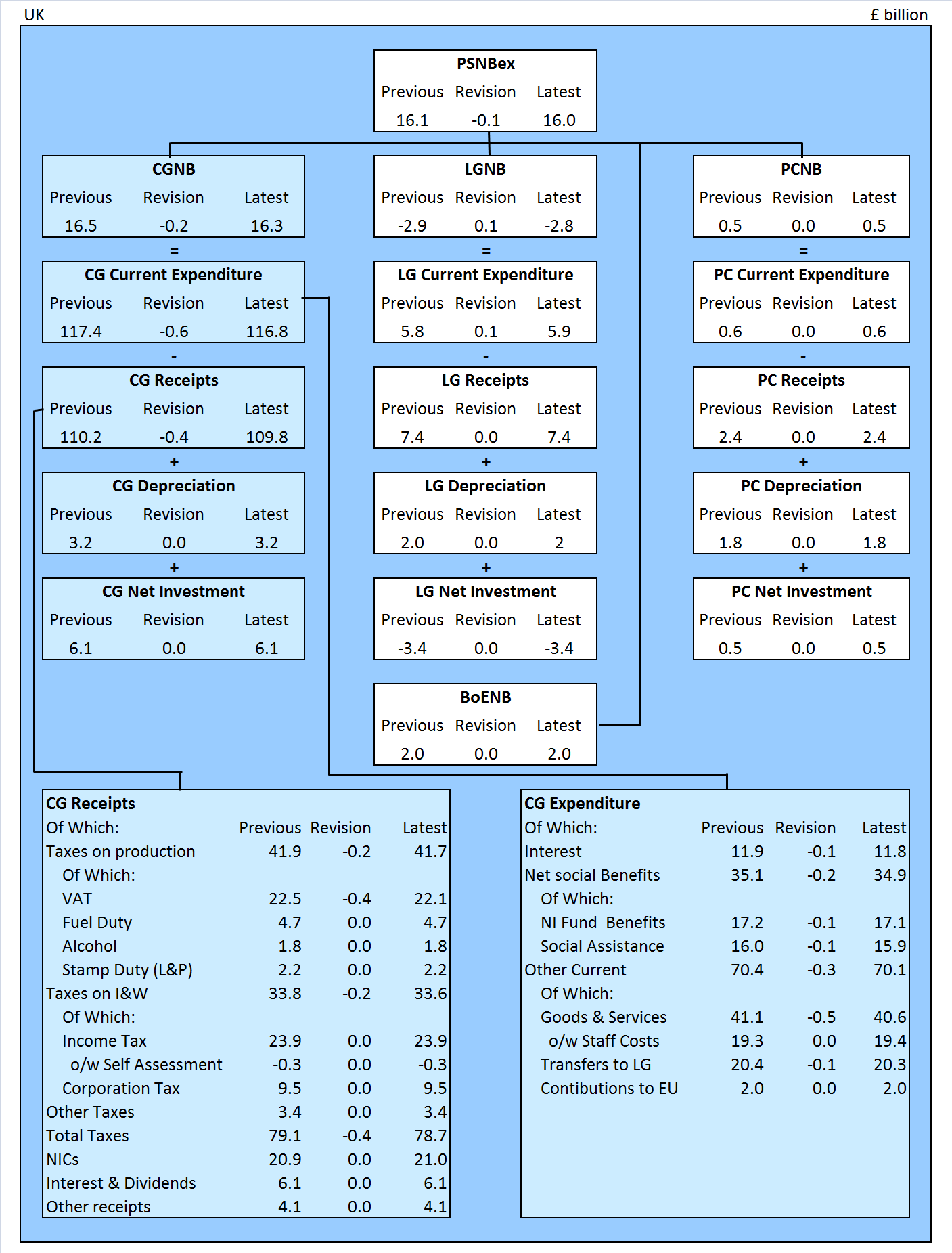
Source: Office for National Statistics
Notes:
- PSNBex - Public sector net borrowing excluding public sector banks.
- CGNB - Central government net borrowing.
- LGNB - Local government net borrowing.
- PCNB - Non-financial public corporations' net borrowing.
- BoENB - Bank of England net borrowing.
- L&P - Land and property.
- I&W - Income and wealth.
- NICs - National insurance contributions.
- Contributions to EU - UK VAT, GNI and abatement contributions to the EU budget.
Download this image Figure 11: Latest estimate of public sector net borrowing (excluding public sector banks) over the period April to May 2017, compared with that presented in the previous bulletin (21 June 2017)
.png (144.2 kB) .xls (68.1 kB)Revisions to net cash requirement
On 4 July 2017, UK Asset Resolution Limited (UKAR) published its 2017 Annual Report and Accounts. These data have been used in this month’s dataset and as a result central government net cash requirement has increased by £5.0 billion for the financial year ending March 2017. These data have also been used to update our forecasts beyond March 2017, resulting in an increase in central government net cash requirement in the current year-to-date (April to May 2017). Further, as a result of this work we have re-profiled the net cash requirement of UKAR in the financial years ending March 2015 and March 2016, though there are no net changes to the financial year estimates.
Revisions to net debt at the end of May 2017
Since the previous publication, the estimate of public sector net debt excluding public sector banks (PSND ex) recorded at the end of May 2017 has decreased by £6.6 billion. Of this £6.6 billion revision, £5.8 billion is a timing effect, whereby a cash receipt previously expected by the Term Funding Scheme in June 2017 was received and recorded in May 2017.
Incorporating data from the BoE 2017 annual report has reduced the level of PSND ex from June 2016 to date, with the estimate of net debt at the end of May 2017 reducing by £0.8 billion as a result of these data.
Revisions to public sector banks data
This month, we have received updated profit and loss statement data for public sector banks (now only Royal Bank of Scotland). These updates, extending from July 2016 to December 2016, have resulted in revisions to both public sector net borrowing but have no impact on the “ex” measures. These data have also been used to update our BoE forecasts beyond December 2016.
As a result of this work, the estimate of the public sector bank’s contribution to net borrowing has increased by £1.3 billion in the financial year ending March 2017 and £0.3 billion in the current financial year-to-date (April to May 2017).
The reporting of errors in the public sector finance dataset
It is important to note that revisions do not occur as a result of errors; errors lead to corrections and are identified as such when they occur.
Quality assurance of our recording of the Royal Mail share sales and associated share gifting to Royal Mail employees has highlighted that we did not fully record the share disposal in October 2015. This month we have recorded the share sale of £591 million in October 2015. There have been no revisions to public sector net borrowing or net debt (both the ex or inclusive measure) as a result of this work.
Further investigation has revealed the double counting of the £331 million capital transfer associated with the October 2013 share sale. This has now been corrected resulting in a decrease of £331 million to public sector net borrowing (both the ex or inclusive measure) in that month.
Nôl i'r tabl cynnwys12. International comparisons of borrowing and debt
The UK government debt and deficit for Eurostat statistical bulletin is published quarterly (in January, April, July and December each year), to coincide with when the UK and other EU member states are required to report on their deficit (or net borrowing) and debt to the European Commission.
On 17 July 2017, we published the latest UK government debt and deficit for Eurostat statistical bulletin, consistent with the May 2017 public sector finances bulletin (21 June 2017). In this publication we stated that:
general government gross debt was £1,720.1 billion at the end of March 2017, equivalent to 88.0% of gross domestic product (GDP); an increase of £68.1 billion on March 2016
general government deficit (or net borrowing) decreased by £28.2 billion to £47.0 billion (equivalent to 2.4% GDP) in the financial year ending March 2017 (April 2016 to March 2017), compared with the previous financial year
This bulletin reports an unchanged an estimate of general government gross debt and a £0.4 billion reduction to the estimate of deficit in the financial year ending March 2017, compared with those published on 17 July 2017.
It is important to note that the GDP measure, used as the denominator in the calculation of the debt ratios in the UK government debt and deficit for the Eurostat statistical bulletin, differs from that used within the public sector finances statistical bulletin.
An article, The use of GDP in public sector fiscal ratio statistics explains that for debt figures reported in the monthly public sector finances, a 12-month GDP total centred on the month is employed, while in the UK government debt and deficit for Eurostat statistical bulletin, the total GDP for the preceding 12 months is used.
Nôl i'r tabl cynnwys13. Quality and methodology
The public sector finances Quality and Methodology Information report contains important information on:
- the strengths and limitations of the data and how it compares with related data
- uses and users of the data
- how the output was created
- the quality of the output including the accuracy of the data
UK Statistics Authority assessment of public sector finances
On 20 June 2017, the UK Statistics Authority published a letter confirming the designation of the monthly public sector finances bulletin as a National Statistic. This letter completes the 2015 assessment of public sector finances.
In order to meet the requirements of this assessment we published an article, Quality assurance of administrative data used in the UK public sector finances. This report provides an assessment of the administrative data sources used in the compilation of the public sector finances statistics in accordance with the UK Statistics Authority’s Administrative Data Quality Assurance Toolkit.
How are classification decisions made?
Each quarter we publish a forward workplan outlining the classification assessments we expect to undertake over the coming 12 months. To supplement this, each month a classifications update is published, which announces classification decisions made and includes expected implementation points (for different statistics) where possible.
Classification decisions are reflected in the public sector finances at the first available opportunity and, where necessary, outlined in this section of the statistical bulletin.
The Monthly statistics on the public sector finances: a methodological guide was last updated in August 2012. We are currently working to update this publication in 2017.
Figures expressed as a ratio of gross domestic product
At the end of each financial year, while data for current budget deficit, net investment and net borrowing for the final quarter of the financial year (January to March) are available, gross domestic product (GDP) for the corresponding period is not. To enable us to publish estimates of these figures as ratios of GDP for the latest full financial year, the final quarter of the GDP denominator is estimated based on forecasts produced by the Office for Budget Responsibility (OBR).
This estimate of GDP will be used in the March, April and May publications and revised in the June publication when the published value of GDP becomes available.
Further details on classification decisions and data changes that impact on this (and future) publications
Green Investment Bank
On 20 April 2017, the government announced the sale of Green Investment Bank (GIB plc) to Macquarie Group Limited. The sale is expected to complete in the middle of 2017. The implications of this sale on public sector finances will be announced in due course.
Diverted Profits Tax
As of March 2017, total Corporation Tax includes Diverted Profits Tax (DPT). Although these are different taxes, they have been combined to prevent the publication of disclosive taxpayer information.
Blue Book 2017
In September 2017, the public sector finances will incorporate methodological improvements being implemented for the annual UK National Accounts publication, the Blue Book 2017. These improvements will include updated estimates for gross fixed capital formation (GFCF), specifically with regard to estimates for the cost of transfer of fixed assets (such as legal costs incurred at point of sale of a property) and the net acquisition of entertainment, literary and artistic originals (such as film and TV recordings).
The first of these improvements will not affect the fiscal aggregates for the financial year ending March 2015 onwards (either net investment or net borrowing), as public sector data sources already include expenditure on costs of transfer. There will be revisions for earlier financial years as a result of removing existing negative estimates of transfer costs.
The second of these improvements is expected to impact the public corporations sub-sector by both increasing net investment and decreasing current budget deficit by equal and offsetting amounts (expected to be less than £0.5 billion) in recent years, with no effect, therefore, on public sector net borrowing. It will not affect general government estimates.
We have published an article National Accounts articles: Impact of Blue Book 2017 changes on current price gross domestic product estimates, 1997 to 2012 explaining these methodological improvements in more detail.
Supporting documentation
Documentation supporting this publication is available in appendices to the bulletin.
- Appendix A – Public sector finances tables 1 to 10
- Appendix B – Large impacts on public sector fiscal measures excluding financial intervention (one-off events)
- Appendix C – Revisions analysis on several main components of the central government account (current receipts, current expenditure, net borrowing and net cash requirement)
- Appendix D – Public sector current receipts table
- Appendix E – Impact of the reclassification of housing associations into the public sector: the financial year ending March 2009 to the financial year ending March 2017
- Appendix F – Supplementary fiscal measures
- Appendix G – Revisions to the first reported estimate of financial-year-end public sector net borrowing (excluding public sector banks) by sub-sector
Public sector borrowing by sub-sector
Each month, at 9.30am on the working day following the public sector finances statistical bulletin, we publish Public sector finances borrowing by sub-sector.This release contains an extended breakdown of public sector borrowing in a matrix format and also estimates of Total Managed Expenditure (TME).
Nôl i'r tabl cynnwys
